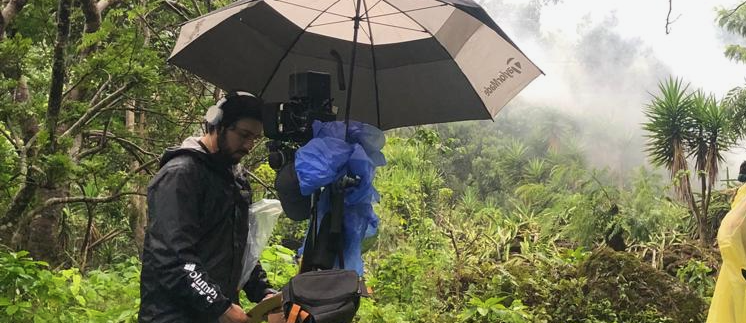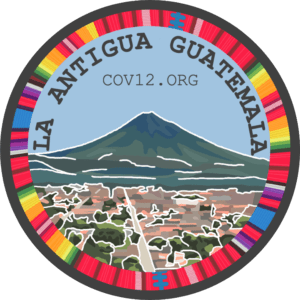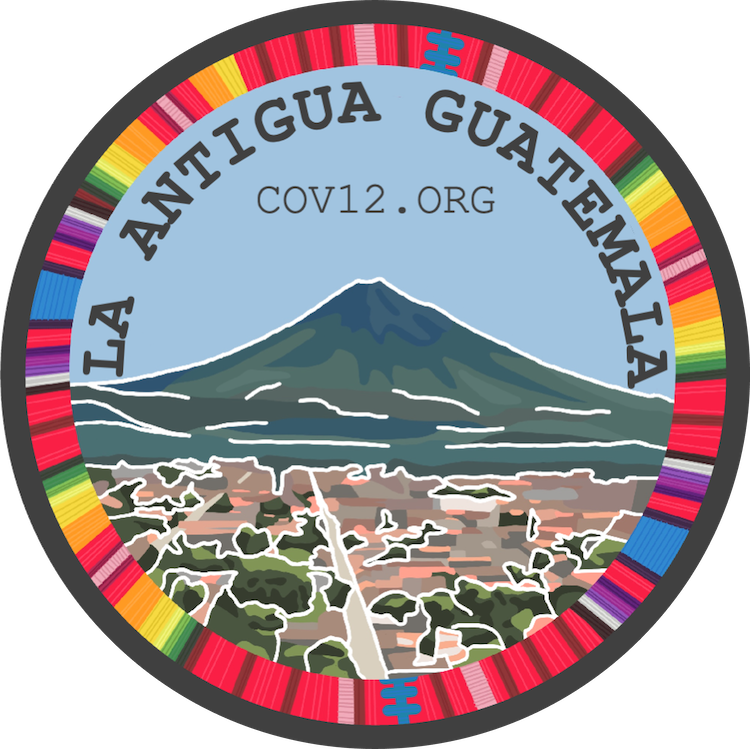Volcanoes, the Humanities and Creative Arts
Volcanes, las Humanidades y las Artes Creativas



Volcanoes, the Humanities and Creative Arts
Volcanes, las Humanidades y las Artes Creativas
201 “Rapsodia telúrica”, un cortometraje sobre música contemporánea e infrasonidos volcánicos
Formato: Proyección y conversatorio
Aceptará resúmenes: No
Convocantes: Guillermo Escalón, Igor de Gandarias
Contacto: guillermoescalon@hotmail.com
Descripción:
Proyección del cortometraje “Rapsodia Telúrica” de Guillermo Escalón e Igor de Gandarias, seguido de un conversatorio.
Igor de Gandarias, un destacado compositor guatemalteco de música contemporánea ha sido motivado por la telúrica de su país para realizar una obra sinfónica basada en los sonidos provenientes de la cadena volcánica. Siguiendo los procedimientos musicales derivados de la música electroacústica, el compositor realiza una serie de grabaciones in situ al tiempo que se asesora con vulcanólogos para poder expresar, organizadamente, lo que sería la música más antigua del planeta.
Un protagonista no-humano se convierte en su confidente artístico: el volcán de Fuego. El 3 de junio del año 2018 un incidente trágico termina momentáneamente con su proyecto, pero nuevas posibilidades se abren para su trabajo con la aparición de los sensores de infrasonidos instalados alrededor del volcán después de la tragedia. Una nueva ventana musical se abre para su trabajo: el mundo de las sonoridades no audibles.
Una aventura artística singular fuera de los marcos habituales de la sociedad y la cultura.
Panelistas: Guillermo Escalón, Igor de Gandarias
202 Eruption! The (Re)mediation of Volcanoes in Film, Media and Popular Culture
Format: Presentations and panels
Accepts abstracts: Yes
Types of contributions: oral presentations and posters
Conveners: Charlotte Gleghorn, Julie Cupples, Raquel Ribeiro, Kevin Glynn
Contact: raq.ribeiro@gmail.com
Description:
Glynn and Cupples (2022: 16) write that ‘volcanoes have become powerful cultural signs that have repeatedly been mobilized in the service of distinct Central American political projects and narratives, both colonial and decolonial’. This session aims to build upon, expand and explore this insight by examining the meanings and uses of volcanoes that have developed through popular cultural practices of representation, including narrativization, appropriation and (re)mediation in music, television, film, social media and other digital spaces. There is, for example, a long history of the deployment of volcanoes for purposes of both narrative and spectacle in popular media, including in films such as The Last Days of Pompeii (1926, 1935, 1959), Krakatoa, East of Java (1968), Dante’s Peak (1997), and Cenizas (Ashes, 2018), and TV shows like Doctor Who (1963-), Children of Fire Mountain (1979), and Katla (2021). In Nicaragua, a revolutionary musical genre of protest song known as VolCanto was powerfully resurrected during the 2018 uprising under the slogan ‘juntos somos un volcán’ (‘together we are a volcano’). Moreover, there is an expanding body of social media engagement with and around volcanic activity and disasters, and a recent cycle of high-profile films that explore volcanoes and their enthusiasts, destructive powers, and audiovisual archives, including Into the Inferno (2016), The Volcano: Rescue From Whakaari (2022), and Fire of Love (2022), all of which invite scholarly examinations of volcanic narratives, tropes, landscapes, particularities, and political potencies, provocations and potentialities. We invite scholars working on these and related areas to propose 20-minute presentations on issues around volcanic media, such as the meanings they ascribe and attach to volcanoes and volcanism, their contributions to and production of popular imaginaries (including regarding how to live with volcanoes), and the political narratives and projects to which they may give rise across different sites of struggle.
203 “Fire up a mountain and nobody there to put it out” – Living with Volcanoes in Song, Story, Poetry, and Music [español]
Format: Presentations and performances
Accepting abstracts: Yes
Types of contributions: Diverse (see description below and please select the option “other” when submitting your abstract)
Conveners: Thomas A. McKean, Maxwell ‘Tajoe’ Francis, James Christie
Contact: enl111@abdn.ac.uk
Description:
How do people use song, story, poetry, and music to make sense of the multi-valent complexities of living with volcanoes?
In dormancy, a volcano may be a rich source of productive soil, connection to the land, geothermal heat, wood for cooking, tourist income, and more, while at other times full of risk, and danger. Thus our emotional responses may range from the spiritual and aesthetic to powerful mechanisms for processing loss, death, and tragedy.
Joy, respect, relief, or fear and sorrow, structured communicative forms give us bounded and safe frameworks for the expression of our deepest feelings. From poems of quotidian life on a volcano’s flanks to school children’s specifically elicited responses in song twenty years after the Montserrat eruption of 1997, these artistic products offer a mechanism for processing experiences and their lasting legacies. Narrative responses can also be used in preventive ways, as with the New Zealand government’s ‘Matt’s Volcano Story’ leaflet, which brings to life emergency response advice in the event of an eruption or related phenomena.
We invite contributions in any format from academics, composers and poets, performers, and other artists looking at responses to volcanic environments, whether reflecting human-place interdependence, or catastrophic environmental events.
Contributors could include community members, scientists involved with community co-production, artists (singers, musicians, poets), creative workshop leaders, and more.
203 “Que se incendie una montaña y que nadie esté allí para apagarla” – Convivir con los volcanes en la canción, el cuento, la poesía y la música
Formato: Presentaciones e interpetaciones
Aceptará resúmenes: Sí
Tipos de contribuciones: Diversas (lee la descripción de abajo y, por favor, selecciona la opción “otra” cuando envíes tu resumen)
Convocantes: Thomas A. McKean, Maxwell ‘Tajoe’ Francis, James Christie
Contacto: enl111@abdn.ac.uk
Descripción:
¿Cómo la gente utiliza la canción, la historia, la poesía y la música para dar sentido a las complejidades multivalentes de vivir con volcanes?
En estado latente, un volcán puede ser una rica fuente de suelo productivo, conexión con la tierra, calor geotérmico, leña para cocinar, ingresos turísticos y mucho más; mientras que en otras ocasiones está lleno de riesgos y peligros. Así, nuestras respuestas emocionales pueden ir desde lo espiritual y estético hasta poderosos mecanismos para procesar la pérdida, la muerte y la tragedia.
Alegría, respeto, alivio, o miedo y tristeza; las formas comunicativas estructuradas nos proporcionan marcos delimitados y seguros para la expresión de nuestros sentimientos más profundos. Desde los poemas sobre la vida cotidiana en las laderas de un volcán hasta las respuestas específicamente suscitadas en las canciones de los escolares veinte años después de la erupción de Montserrat de 1997, estos productos artísticos ofrecen un mecanismo para procesar las experiencias y sus secuelas duraderas. Las respuestas narrativas también pueden utilizarse con fines preventivos, como en el caso del folleto “Matt’s Volcano Story” del Gobierno de Nueva Zelanda, que brinda consejos de respuesta ante una emergencia en caso de erupción o fenómenos relacionados.
Invitamos a académicos, compositores y poetas, intérpretes y otros artistas a que nos envíen sus contribuciones, en cualquier formato, sobre las respuestas a entornos volcánicos, ya sea como reflejo de la interdependencia entre el ser humano y el lugar o de catástrofes medioambientales.
Pueden contribuir miembros de comunidades, científicos involucrados en co-producción comunitaria, artistas (cantantes, músicos, poetas), líderes de talleres creativos, etc.
204 Festival de artes volcánicas – un diálogo de saberes inspirado por volcanes [English]
Formato: Open fair/exhibition
Acceptará resúmenes: Sí
Tipos de contribuciones: Diversas (ver la descripción abajo y por favor seleccionar la opción “otras” al enviar su resumen)
Convocantes: Teresa Armijos, Naomi Irapta, Ailsa Naismith, Monique Johnson, Thomas McKean
Contacto: t.armijos@ed.ac.uk
Descripción:
Los volcanes son poderosos monumentos de la naturaleza que amenazan vidas y medios de subsistencia y al mismo tiempo inspiran asombro, expresión artística y cultural de varias formas.
Aunque las personas pueden experimentar un volcán de maneras muy diferentes (una vista a través de su ventana, la pantalla de una computadora de un científico que lo monitorea, un mapa de peligros de protección civil), se puede desarrollar una verdadera comprensión mutua creando espacios y caminos en los que las personas puedan intercambiar sus conocimientos y experiencias particulares. , y el conocimiento. Los volcanes también pueden permitirnos explorar cómo nos relacionamos con el paisaje, las erupciones, las ideas de identidad, lugar y memoria. La sesión permitirá un espacio para compartir reflexiones individuales y obras de arte coproducidas que documenten y celebren experiencias colectivas y conocimientos múltiples.
Invitamos presentaciones basadas en métodos de investigación interdisciplinarios y transdisciplinarios, obras de arte, incluidas expresiones visuales y reflexiones de investigadores en el campo. Esperamos atraer trabajos producidos en proyectos que hayan reunido a personas o grupos utilizando métodos creativos para generar resultados colaborativos. También invitamos intervenciones artísticas que aborden la comprensión, la interpretación de paisajes volcánicos y/o la coproducción de conocimiento en áreas volcánicas, junto con la reducción del riesgo volcánico a través de métodos artísticos.
Proponemos una feria (o exposición) en la que se pueda presentar trabajos (fotografía, vídeo, textiles, poesía, dibujos, pinturas, etc.) con breves descripciones de proceso, inspiración o reflexión.
La exposición permanecerá abierta durante toda la conferencia. De acuerdo con la entrega bilingüe de CoV12, el idioma de texto y audio utilizado en la descripción y traducción de obras puede estar en inglés o español (por ejemplo, subtítulos de videos) o ambos.
Los convocantes somos un grupo con diversas experiencias, relaciones y conexiones con comunidades que viven con y en volcanes y áreas de rica geodiversidad donde se han puesto en práctica métodos interdisciplinarios. Somos un grupo que representa varios lugares de América Latina (Guatemala, Ecuador, Colombia), el Caribe (San Vicente, Trinidad, Montserrat), Filipinas y el Reino Unido. Esperamos recibir presentaciones de diferentes partes del mundo para complementar este grupo ya diverso y seguir aportando al dialogo de saberes intercultural.
204 Festival of volcanic art: a dialogue of knowledges inspired by volcanoes
Format: Open fair/exhibition
Accepts abstracts: Yes
Types of contributions: Diverse (see description below and please select the option “other” when submitting your abstract)
Conveners: Teresa Armijos, Naomi Irapta, Ailsa Naismith, Monique Johnson, Thomas McKean
Contact: t.armijos@ed.ac.uk
Description:
Volcanoes are powerful monuments of nature that threaten lives and livelihoods while simultaneously inspiring awe, artistic inquiry and expression.
Although people may experience a volcano in widely different ways – a view through their window, a monitoring scientist’s computer screen, a civil protection hazard map – true mutual understanding can be developed by creating spaces and pathways in which people can exchange their particular expertise, experience, and knowledge. Volcanoes can also allow us to explore how we engage with the landscape, eruptions, ideas of identity, place and memory. The session will allow space for sharing both individual reflections and co-produced artwork that documents and celebrates collective experiences and multiple knowledges.
We invite submissions based on interdisciplinary and transdisciplinary research methods, art pieces, including visual expressions, and reflections from researchers in the field. We hope to attract works produced in projects that have brought people together to practise creative methods for making collaborative outputs. We also welcome artistic interventions that deal with understanding, interpreting volcanic landscapes and/or the co-production of knowledge in volcanic areas, along with volcanic risk reduction through artistic methods.
We propose a fair (or exhibition) to which people can submit their work (photography, video, textiles, poetry, drawings, paintings, etc.) with short descriptions of process description, inspiration or reflection.
The exhibition will run throughout the conference. In line with CoV12 being delivered bi-lingually, text and audio language used in the description and translations of non-English/Spanish works (e.g. video subtitles) may be in English, Spanish, or both.
The conveners have experiences, relationships, connections to communities living with volcanoes and areas of rich geodiversity where interdisciplinary methods have been in practice – and are practitioners themselves. Here we would have representation from Latin America (Guatemala, Ecuador, Colombia), the Caribbean (St. Vincent, Trinidad, Montserrat), the Philippines, and the UK. We hope to get submissions from different parts of the world to complement this already diverse group.
205 Beyond hazard maps? Exploring methods, media and the map-making process to consider new opportunities in map making practices and their alignment with disaster risk reduction.
Format: Presentations and round table discussion
Accepts abstracts: Yes
Types of contributions: oral presentations and posters
Conveners: Neil Stuart, Lisa Mackenzie, Thomas McKean, Jeremy Phillips, Matthew Watson, Eliza Calder
Contact: l.mackenzie@ed.ac.uk & n.stuart@ed.ac.uk
Description:
This session will address how we might think with conceptual precision about the future of map-making practices and their alignment with DRR. The session invites presentations that open new questions as to the agency of cartographic practices to think, feel, envisage and explore the complex social and ecological relationships that exist in Volcanic Landscapes.
The session also seeks to understand how practices formulated through mapping might usefully attend to both inclusions and exclusions between people and nature in the living landscape. We are further interested in the way in which dynamic processes in the landscape (both in terms of environmental change and socio-cultural displacements and recoveries) might be meaningfully represented through collaborative mapping action.
We particularly welcome presentations that address the way in which map making can facilitate exchanges between practices of scientific and non-scientific thinking, to gain relevance and weave different realities of place together. The session seeks contributions that are both pragmatic and speculative in their orientation and that are unafraid to release mapping from its habits and conventions towards transformative relationships of enablement with the living landscape. For these reasons, methods and outputs of participatory mapping, counter-mapping, speculative mapping, sketch mapping and other relevant approaches for extending more traditional forms of volcanic hazard mapping and hazard representation, in both digital and physical media, are warmly encouraged.
After the talks we propose a short synthesis session where we begin drawing together insights and assertions. Speakers and session participants will be encouraged to help us jointly formulate how these current practices and outputs can be recognised as valid inclusions in the set of future map-making practices for recording, drawing, writing, and moving through space.
Comité organizador de programa:
Program Organising Committee:
Pablo Forte, Eliza Calder, Beatriz Cosenza-Muralles, Lizzette A. Rodríguez
cov12program@gmail.com


